I am excited to be adding spoken word versions of my poetry to Image & Verse. A number of them are up now, and there will be many more to come.
Author: Rob Kistner
Unmask
This is my post for Sunday Scribblings, May 20th, 2007.
Stretched
This is my second post for Poetry Thursday, May 17, 2007. This post contains a written version of the poem and an alternate “spoken word” version.
Continue reading Stretched
The Cast
Author’s note: I love fly-fishing the breathtaking Cascade mountain streams near my home. Native trout are plentiful, and very active. The sound of the rushing water, the crisp breeze in the conifers, backlit by sunrise, is absolutely intoxicating.
The body rhythms of fly-casting are so engaging, and when surrounded by such natural beauty — it’s mesmerizing! It is a Zen-like experience, in which I loose myself completely, escaping the stress and pressures of day-to-day life.
The fluid feel of the cast is exhilarating. I wrote this poetic homage to the experience.
Continue reading The Cast
Blueberry Elf
This is a whimsical post in response to the Poetry Thursday May 17th prompt.
Dreams
Sentenced
This is my post for the Sunday Scribblings’ May 13th prompt: “second chanceâ€.
Lost in Azure
This is the post for my Poetry Thursday’s May 10th prompts: azure and erode. Continue reading Lost in Azure
I Remember the World of Tomorrow
The title of this post is a lyric from the Todd Rundgren song “Future”, which appears on his “Liars” CD from 2004. Being a child in the 50’s and a college student in the 60’s, that phrase struck me on a number of levels, beyond the paradox it represents. Without having to hear the lyrics I understood the song was a lament regarding the unfulfilled naive vision we all held 50 years ago of what the future would be.
UTOPIA
We envisioned a utopia of peace and freedom, flying cars, colonies on other planets, computers that existed in the background of daily life serving our every whim, eternal youth, and everlasting health. With robots liberating us from the grind of mundane or oppressive work, we believed we’d have time on our hands to pursue a life of art, culture, philosophy — in a clean, shiny, thriving, modern world of tomorrow. Space travel would be available to all.
The Jetson’s in 1962 may have been a television cartoon series, but it also spoke to a collective dream, a hope we here in America shared — even if we did so with a foolish innocence. Walt Disney’s Tomorrowland, which opened in 1955, the 1964 New York’s World’s Fair, and Disney’s Epcot Center, first conceived in 1966 — these were all hopeful visions of a future world that would be utopian in nature.
LOSS OF INNOCENCE
The problem with those particular perspectives is that they were not only absurdly innocent, they were dangerously narrow. We hoped that the emergence of technology itself would elevate the condition of mankind, perhaps even the very nature of man.
That foolhardy innocence of America has been dismantled piece by piece beginning in the 60’s, into the 70’s, and to now — the result of assassinations, riots, wars, terrorism, and global environmental decline that may in fact now threaten our very existence.
TECHNOLOGY: SERVANT OR MASTER
At the same time technology has advanced in ways we couldn’t even comprehend 50 to 60 years ago. It did not, in and of itself, elevate the condition of man. There are some who would say that today, the computer does not serve us — we serve the computer.
While I fully believe that certain aspects of technology have advanced well beyond man’s ability to keep pace, contributing to a great deal of the overriding stress in today’s civilization — I do not believe that technology is a bad thing. I am not a neo-luddite. I believe technology is capable of great good and great evil. The uncertain component is the human component.
CAN WE, SHOULD WE
There is a line from Jurassic Park, spoken by Jeff Goldblum’s character, the chaotician Ian Malcolm, that resonates with me in a similar manner as does the title of this post. Speaking in the midst of the catastrophe that InGen had created by cloning the dinosaurs, Ian said, “Yeah, but your scientists were so preoccupied with whether or not they could, they didn’t stop to think if they should.”
Today, like no other time in the history of mankind, I believe technology places that most critical inquiry at the very center of our lives: could we vs. should we? As we now pull back the veil on bioengineering, nanotechnology, brain-computer interface (BCI), we need to seriously delve into this “could we / should we” question.
I am not looking at this from a moral perspective, I will leave that to others so inclined. I am considering this strictly from a survival of the species point of view.
GREATEST ERA OR END OF DAYS
As James Martin, one of our great modern thinkers and author of the “The Meaning of the 21st Century” points out in his most optimistic and uplifting book, man stands on the threshold of either the greatest era in human history, or the end of life as we know it — and the outcome rests in our hands.
He acknowledges that this profound conclusion has been reached before in history, but he goes into most convincing detail to demonstrate why this was simply not true in the past, and prove, arguably beyond a shadow of a doubt, that this is an absolute certainty today.
Martin’s book is engaging, compelling, and hyper-relevant. It should be required reading for everyone, especially every corporate, government, and academic leader in the world.
TECHNOLOGY & SOCIAL RESPONSIBILITY
This post is not intended as an infomercial for james Martin, nor is it a negative doom & gloom condemnation of today’s world. However, I cannot ignore the social responsibility we all have with regard to technology.
Rest assured that we have no way to comprehend the magnitude of that which we do not know about the future. Compared to the 1950’s, we have far less leeway today with regard to the naiveté we can afford to carry forward into time. It could prove devastating.
Those who create, manufacture, and distribute technology, as well as those of us who use it — we must all remain mindful of the balance between “can we” and “should we”, and vigilant that we do not tip that scale. If we pay prudent attention to these two questions, and take the responsible steps to restore what imbalance we may have created to date — our future will be a great era of humankind.
Twenty Years
Written for my wife on our anniversary.
The Patient Sea
This was originally written and posted in 2007.”
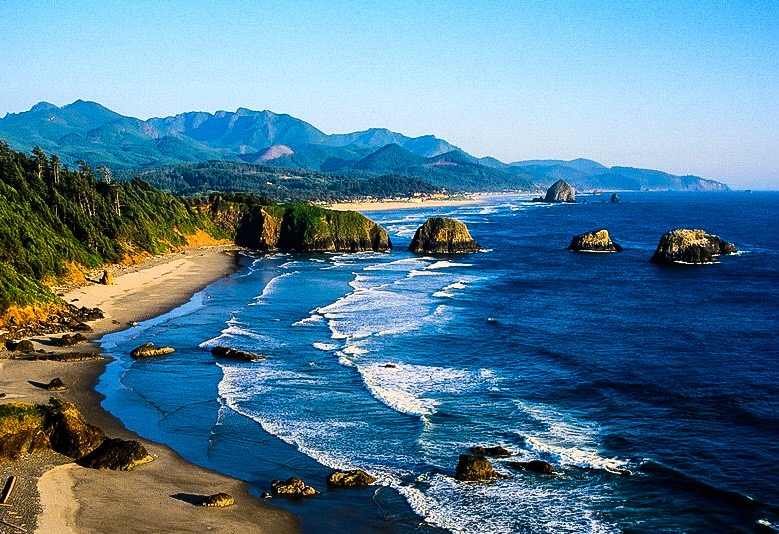
Indian Beach, Oregon Coast
the chest of the wave
slams the massive boulder
the great stone rocks back
undetectably
with a deep thud
more felt than heard
it bumps solid
against the face of the cliff
to which it crowds
as the spent wave recedes
the hulking mass settles again
immovable as bedrock
defying the next swell
and the next
and the next
but the sea is patient
this steadfast giant
in the ebb and flow of time
will acquiesce
becoming the grains of sand
upon which it now rests
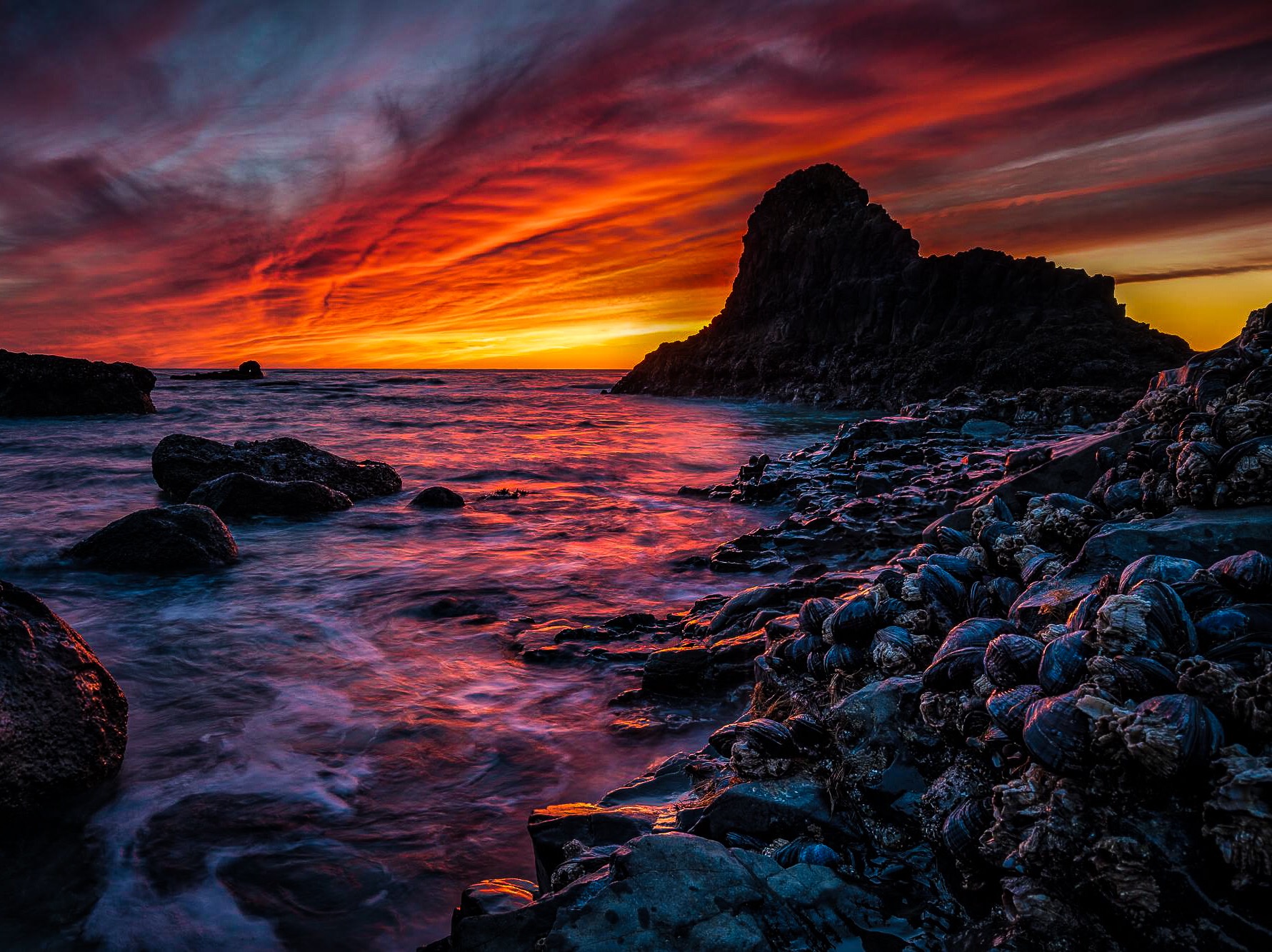
Indian Beach sunset, Oregon Coast
rob kistner © 2007
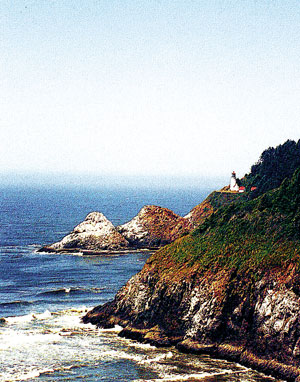
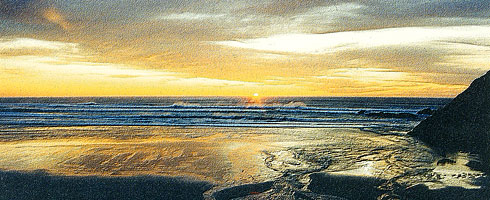
The two photos immediately above I captured years ago in the month of September. The top photo is the Heceta Head lighthouse on the Oregon Coast. I loved the powerful visual impact created by the tiny lighthouse, beside the vast Pacific Ocean. The bottom photo is of sunset at Indian Beach, also on the Oregon Coast. I digitally rendered both originals into giclée on dappled canvass. “Lighthouse” measures 36″W x 46″H and “September Sunset” measures 60″W x 24″H.
NOTE: below are two tighter shots of the Heceta Head lighthouse pictured in the giclée above to give you a better sense of scale. The people pictured in the photo at the very bottom below enhance perspective of scale even further.
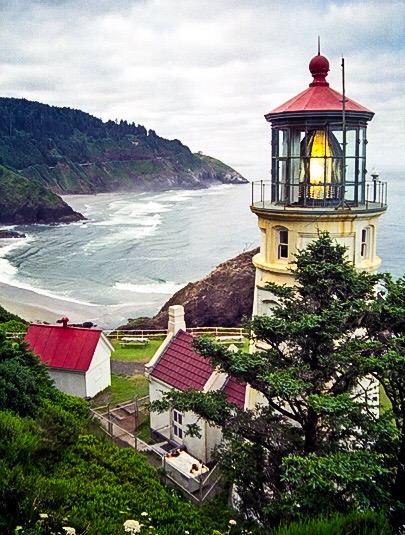

The Bear
Author’s note: This following piece, “The Bear”, is a terrifying tale. My wife and I love hiking the Oregon wilderness on the edge of which we live. Wildlife is still plentiful in the Cascade Mountains. One must always be cautious. This Pacific Northwest is wild and beautiful, but it is still dangerous.
Continue reading The Bear
A Moment
Expectation
Jazz
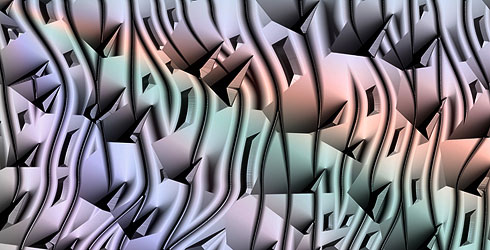
Rob Kistner © 2007
This is a new piece I created as an abstract representation of what jazz might look like if it could be seen with the eye. The shifting colors depict the moods that evolve and change during the improvisational playing, the vibrating lines are the riffs, and the geometric points are the percussive licks. Part of my 3D Geometric series, “Jazz” is a giclée on Arches textured stock, and measures 48″W x 24″H.